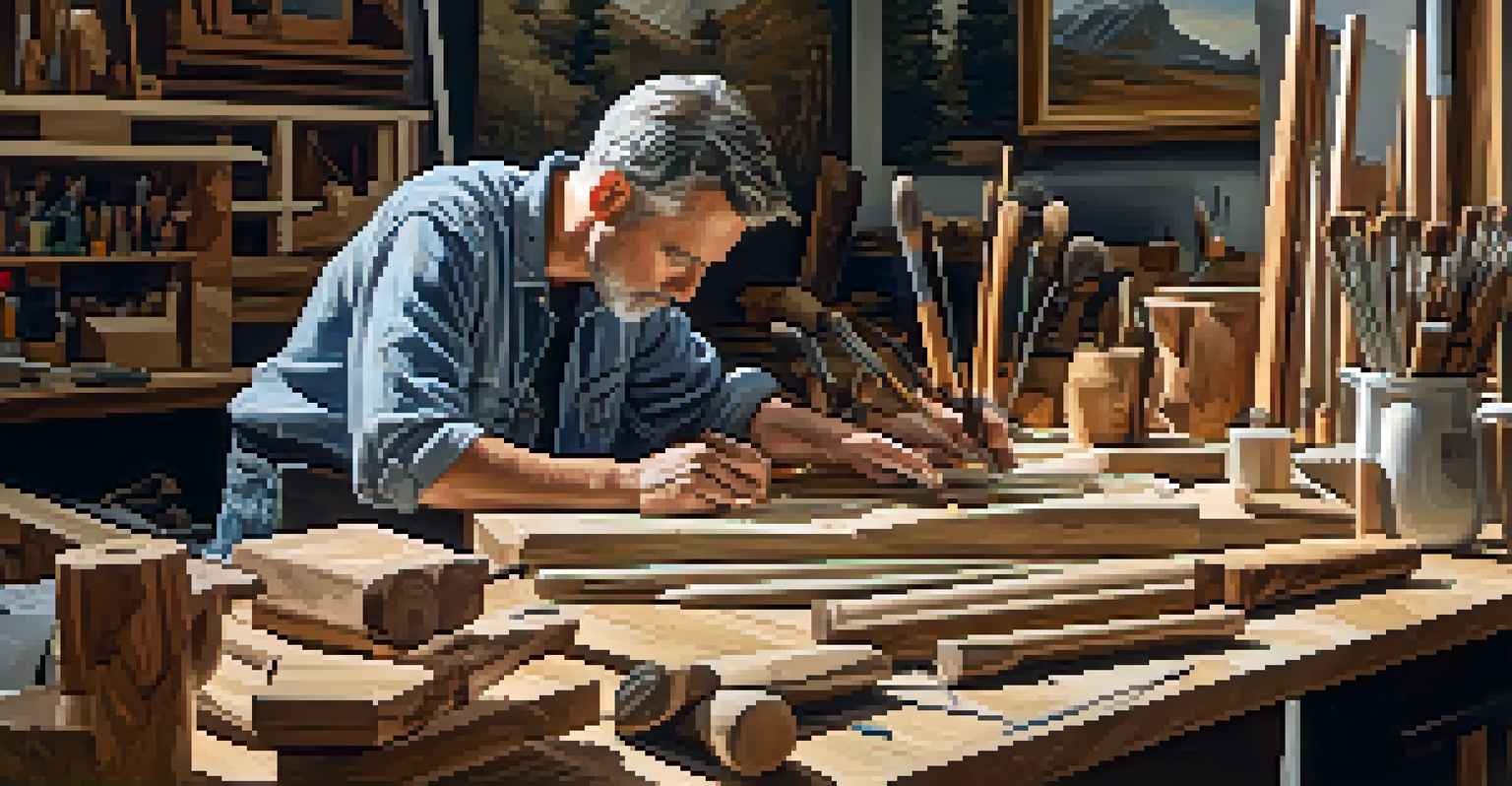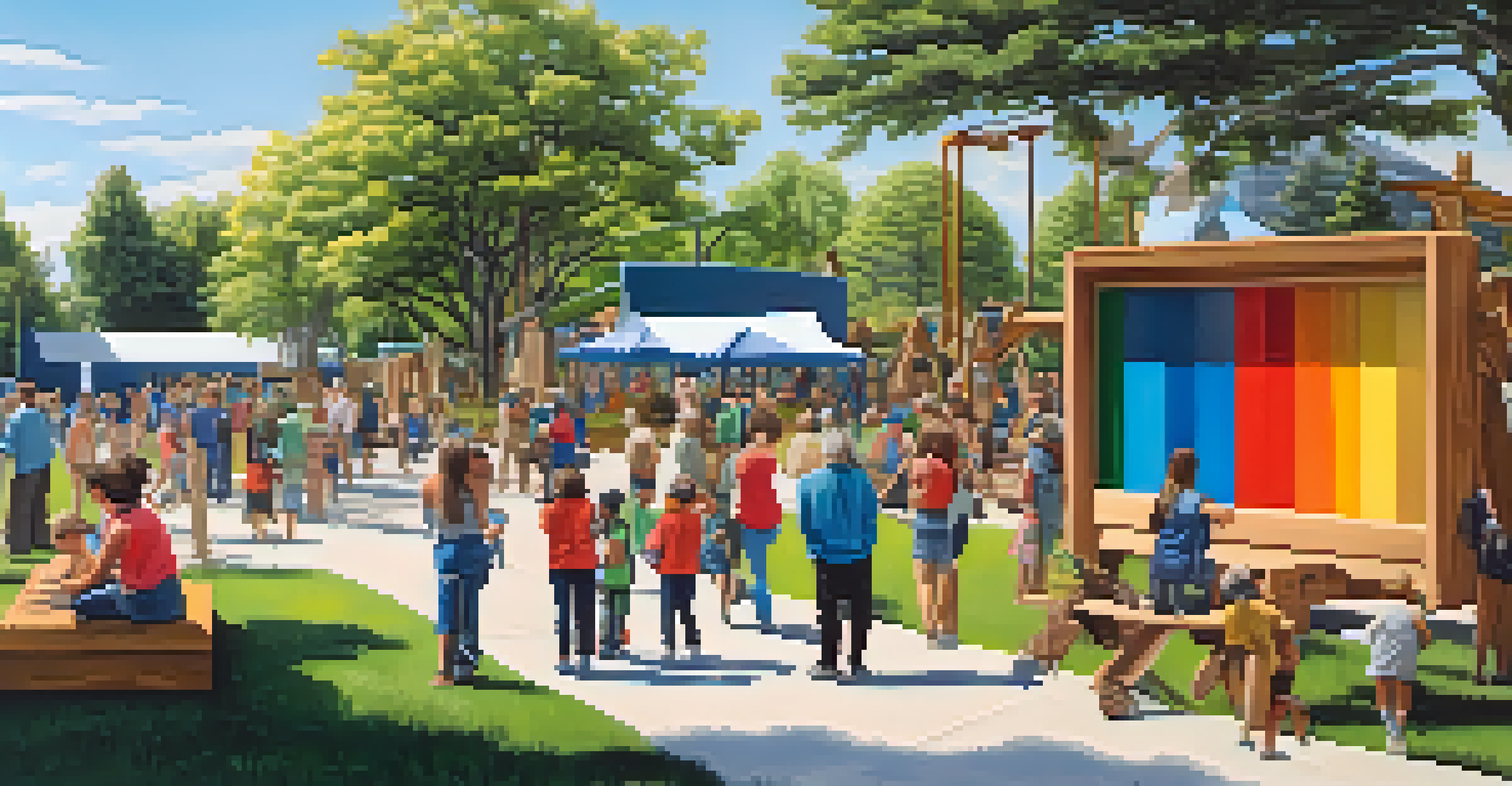Wooden Voices: Carving as a Medium for Environmental Activism

The Intersection of Art and Environmental Advocacy
Carving as an art form can be a powerful tool for environmental activism. Artists use their craft not only to express creativity but to raise awareness about pressing ecological issues. By transforming wood into thought-provoking pieces, they invite audiences to consider the impact of deforestation and climate change.
Art is not a mirror to hold up to society, but a hammer with which to shape it.
For instance, a sculptor might create a piece that symbolizes the fragility of ecosystems, using reclaimed wood to emphasize sustainability. This approach not only highlights the beauty of nature but also serves as a visual reminder of what is at stake. As viewers engage with these artworks, they often find themselves reflecting on their own relationship with the environment.
In this way, carving becomes more than a pastime; it evolves into a dialogue between the artist and the audience. Through storytelling conveyed in wood, artists can inspire action and foster a deeper connection to nature, urging us to protect our planet.
Historical Roots of Wood Carving in Activism
Wood carving has a long history intertwined with cultural expression and activism. Many indigenous communities have used carving to tell stories that resonate with their relationship to the land. These traditional practices often carry messages about sustainability and respect for nature, making them inherently activist in spirit.

For example, totem poles created by Native American tribes serve not only as artistic expressions but also as powerful symbols of cultural identity and environmental stewardship. These carved masterpieces communicate histories and beliefs that emphasize a harmonious existence with nature. Such historical context enriches contemporary discussions around environmental advocacy.
Art as a Tool for Environmental Change
Wood carving serves not only as a creative outlet but also as a means to raise awareness and inspire action regarding environmental issues.
Understanding the legacy of wood carving in activism allows modern artists to draw inspiration from these traditional narratives. By honoring these roots, they can create works that resonate on a deeper level and continue the conversation about environmental responsibility.
Modern Carving Techniques and Their Impact
Today, wood carving has evolved with new techniques and technology, expanding the possibilities for artists. Innovations such as CNC machines allow for precision and creativity that were once unimaginable. However, many artists still choose traditional hand-carving methods to maintain a connection to the material and the environment.
The greatest threat to our planet is the belief that someone else will save it.
This blend of old and new techniques can amplify the impact of an artist's message. For instance, a sculpture created using both hand tools and modern technology might highlight the tension between nature and industrialization. This juxtaposition can provoke thought and encourage viewers to consider the implications of their consumption habits.
Ultimately, the choice of technique can shape the narrative conveyed through the carved piece. As artists experiment with these methods, they continuously push the boundaries of storytelling in environmental activism.
The Role of Community in Wood Carving Projects
Community involvement plays a vital role in wood carving projects focused on environmental activism. Collaborative efforts can forge connections between artists and local residents, fostering a sense of shared purpose. This engagement often leads to projects that reflect the specific environmental challenges faced by the community.
For example, a community might come together to create a large wooden installation that represents local wildlife threatened by habitat loss. Through this collective effort, participants not only learn about the issues but also contribute to a tangible solution that raises awareness. Such projects can galvanize the community and inspire further action.
Sustainability in Carving Practices
Modern wood carvers emphasize sustainability by using reclaimed or responsibly sourced materials, enhancing the environmental narrative of their art.
Moreover, these collaborations can provide a platform for education and discussion about environmental concerns. As artists share their skills and knowledge, they empower community members to become advocates for their own environment.
Sustainability in Wood Carving Practices
Sustainability is a cornerstone of modern wood carving, as artists strive to minimize their environmental impact. Many choose to work with reclaimed or sustainably sourced wood, emphasizing the importance of responsible material use. This commitment not only supports the environment but also enhances the story behind each piece.
Using reclaimed wood can imbue a sculpture with a history, connecting the past with the present. Each knot and grain pattern tells a story, reminding viewers of the life that once thrived in the tree. This narrative adds depth and meaning to the artwork, reinforcing the message of sustainability.
Furthermore, by prioritizing eco-friendly practices, artists set an example for their peers and audiences. This commitment can inspire a broader movement within the art community toward environmentally responsible creation.
Art Exhibitions as Platforms for Activism
Art exhibitions can serve as powerful platforms for environmental activism, showcasing wood carvings that address ecological issues. Through curated shows, artists can highlight their work's social and environmental messages, drawing the attention of visitors and the media alike. These exhibitions often create a space for dialogue and reflection on pressing issues.
For instance, an exhibition might feature wooden sculptures that depict endangered species, accompanied by information about their habitats and threats. This approach not only educates visitors but also encourages them to participate in conservation efforts. The combination of visual art and education can leave a lasting impact.
Community Engagement in Art Projects
Collaborative wood carving projects foster community involvement, addressing local environmental challenges while empowering residents through shared creative efforts.
In this way, exhibitions become more than just displays of art; they transform into movements that inspire change. By engaging the public in meaningful conversations about the environment, wood carving can play an essential role in activism.
The Future of Wood Carving and Environmental Activism
As we look to the future, the relationship between wood carving and environmental activism is likely to deepen. With increasing awareness of climate change and biodiversity loss, artists will continue to explore ways to use their craft to advocate for the planet. This evolving dialogue can inspire new generations of artists and activists alike.
Emerging technologies and materials will also shape the future of wood carving. Artists may experiment with biodegradable materials or use digital mediums to create interactive installations that engage audiences in conservation efforts. This blend of innovation and tradition can lead to fresh narratives that resonate with a broader audience.

Ultimately, the future of wood carving in environmental activism holds great promise. By harnessing the power of art, we can inspire action and create a more sustainable world, one carved piece at a time.